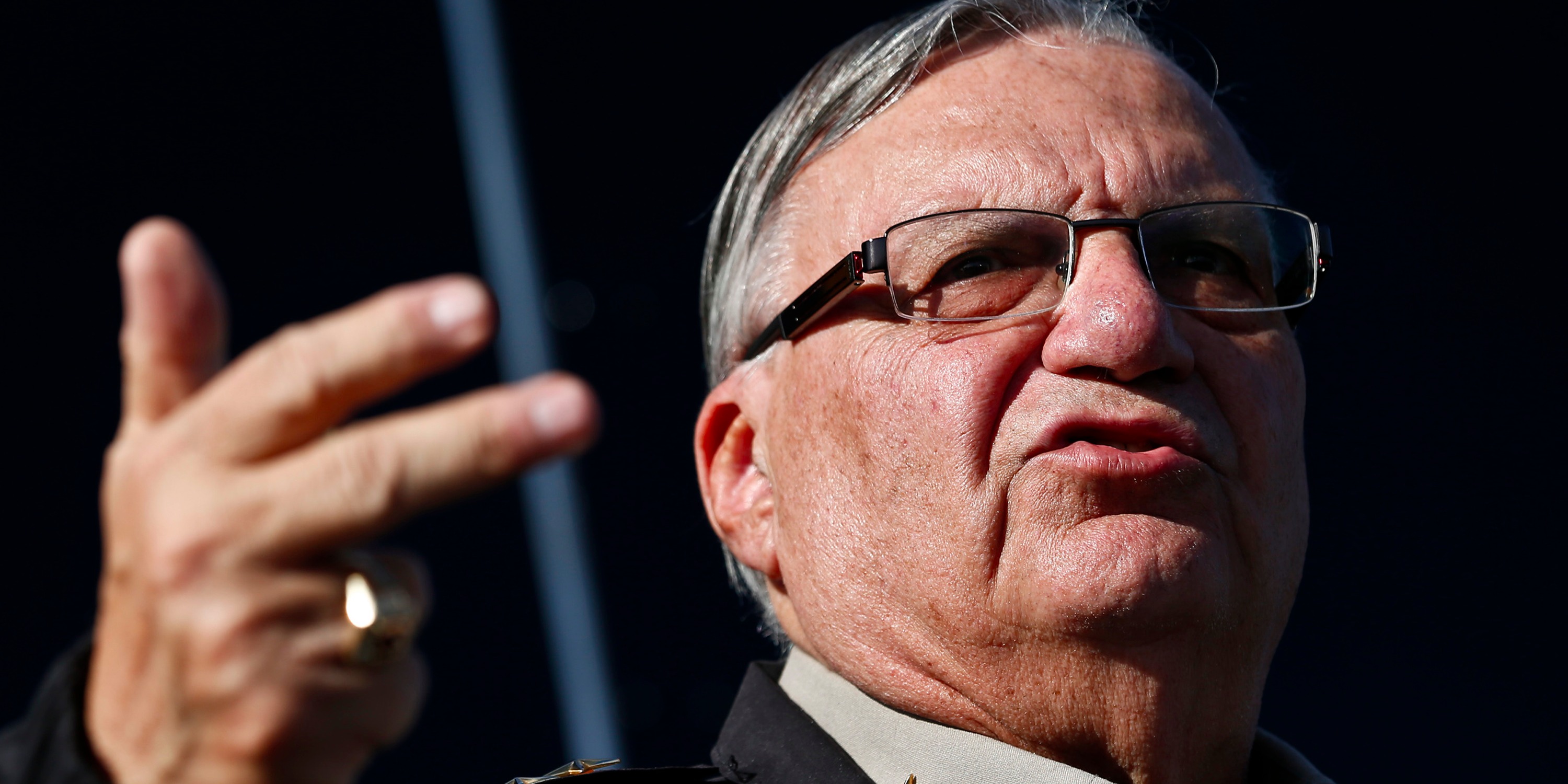- Joe Arpaio, the former sheriff of Arizona’s Maricopa County, said Tuesday he intends to run for US Senate in 2018.
- President Donald Trump pardoned Arpaio last year after Arpaio violated the terms of a court order in a racial-profiling case.
- Arpaio has a lengthy, controversial track record that’s sure to come up in his Senate campaign.
Joe Arpaio, the disgraced former lawman who once called himself “America’s toughest sheriff,” rattled his longtime critics as well as his fellow Republicans on Tuesday when he announced his intent to run for US Senate in 2018.
Arpaio told the Washington Examiner that he believed he had “a lot to offer” and wanted to do everything he could to support President Donald Trump.
“Being a US senator is a little different than being the sheriff, because you can do a lot of things in the US Senate, and I have many plans, believe me,” Arpaio said. “It’s tough. It’s a tough decision. But if you’re going to come across that border, you should be arrested and get the consequences of it.”
The 85-year-old is best known for illegally detaining Latinos and keeping inmates in brutal jail conditions during his 24-year tenure as Sheriff in Maricopa County, Ariz. His aggressive tactics ultimately led to a criminal conviction after he violated a court order to stop racially profiling Latinos.
But Trump set off a political firestorm last August when he issued his first-ever presidential pardon to Arpaio, even before Arpaio was sentenced.
Arpaio had been an early and vocal supporter of Trump during his presidential campaign, so Trump's move was widely expected. Yet that anticipation did little to alleviate the outrage that came mainly from liberals, but also many prominent conservatives.
Several Senate Republicans appeared nervous on Tuesday when asked about their thoughts on Arpaio's announcement, but Sen. Jeff Flake of Arizona, who is not seeking reelection and whose seat Arpaio is eyeing, told Business Insider he thought Arpaio's announcement could be a potential scam to raise campaign funds.
"I will be extremely surprised if Joe Arpaio was in the race a month from now," Flake said.
Arpaio has undoubtedly made national news more than any other sheriff in the nation. He's also undoubtedly the most reviled lawman, too. Here's how one man came to have so much power and engendered so much venom.
The toughest jails ever

Arpaio was notoriously brutal towards inmates. He made headlines for calling his "Tent City" jail a "concentration camp," and for making the inmates there wear pink underwear, eat only two meals a day, and endure unbearably hot temperatures in the summer. Three inmates died after being forced into "restraint chairs" Arpaio kept in his jails.
Arpaio ran for sheriff after in the early '90s, after a 25-year stint with the Drug Enforcement Administration. Arpaio, the son of immigrants from Naples, Italy, "pummeled his opponents with gusto," according to a 2009 profile in The New Yorker.
The main part of his work was operating the county jails, a task he knew had the potential for "political gold." He set to work right away building his Tent City to solve an overcrowding problem. He saved money by ditching salt and pepper at the jails, cutting back to two meals a day, and depriving inmates of their morning coffee.
Sheriff Joe's Tent City - a place where inmates live in Army surplus tents and work in chain gangs - almost immediately captured the attention of the Justice Department. The feds began investigating Tent City in 1995. Two years later, the Justice Department issued a report confirming that Sheriff Joe's infamous Tent City used excessive force and gratuitously used pepper spray and restraint chairs.
Here's how one former inmate named Francisco Chairez, who spent a year in Arpaio's tent city, described it in The Washington Post:
"During the sweltering summer, the temperature could reach 115 or 120 degrees. I was in the tents when we hit 120. It was impossible to stay cool in the oppressive heat. Everyone would strip down to their underwear. There was no cold water, only water from vending machines; and eventually, the machines would run out. People would faint; some had heatstroke. That summer, ambulances came about three times. One man died in his bed.
But the winter was even worse. During the winter, there were no heaters. Most jackets and heavily insulated pants weren't allowed; they don't want you to be comfortable."
The Justice Department gave Arpaio a barely perceptible tap on the wrist. He agreed to a settlement in which he limited use of pepper spray and improved inmates' grievance procedures.
Then-US Attorney Janet Napolitano led the Justice Department investigation and later got Arpaio's endorsement when she ran for governor. Napolitano took a largely hands-off policy toward Arpaio after she won her election.
But Arpaio began to make other enemies, including legal ones. The jail system run by Arpaio was hit with a staggering number of lawsuits by inmates and their families. From 2004 through November 2007, Sheriff Joe and his jails were targeted by 2,150 lawsuits, some of which alleged brutality against inmates, the Phoenix New Times reported.
To put this in perspective, the Phoenix New Times noted that the jail systems in New York, Houston, and Chicago combined were hit with 43 lawsuits that same period.
 Foto: In this May 25, 2016, file photo, people protest against former sheriff Joe Arpaio rally in front of Maricopa County Sheriff's Office Headquarters in Phoenix. source Associated Press/Ross D. Franklin
Foto: In this May 25, 2016, file photo, people protest against former sheriff Joe Arpaio rally in front of Maricopa County Sheriff's Office Headquarters in Phoenix. source Associated Press/Ross D. Franklin
An obsession with immigration that began in 2005
In 2005, Arpaio became "obsessed" with immigration after the state of Arizona passed a law meant to crack down on the smuggling of immigrants, Mother Jones reported. This obsession earned him ire of immigrant advocates in the aughts. In 2008, Phoenix Mayor Phil Gordon attacked Arpaio for his immigration "sweeps" that involved checking random cars for illegal immigrants. Mother Jones' Aura Bogado reported from the trenches of his war on illegal immigration:
Native Americans told me they were targeted because deputies mistook them for Latinos. Latinos told me of being stopped randomly on the street and shouted at-or worse-by officers demanding identification. Alex, a third-generation US citizen, was at a Circle K buying water while his parents waited outside. He ran out when he heard a group of Arpaio's deputies yelling at them to produce their papers.
It shouldn't come as a shock that Arpaio was also a supporter of Arizona's controversial "paper's please" law of 2010 that requires law enforcement to check people's ID if they have a "reasonable suspicion" somebody was in the country illegally.
Arpaio won re-election in 2012 despite huge backlash over that law. He even managed to avoid a recall after a federal judge found he'd engaged in systemic discrimination.
The people of Maricopa County for more than two decades seemed to like him - at least enough people to keep getting him elected. After his 2012 re-election the LA Times noted how impervious his career was to scandal, writing that his career was "apparently coated in Teflon."
Yet by 2016, voters appeared to have tired of Arpaio's constant controversies and endless cycles of litigation. He lost his re-election bid last November to Democratic opponent Paul Penzone, who won the vote with 55% to Arpaio's 45%.
Erin Fuchs contributed to this story.

